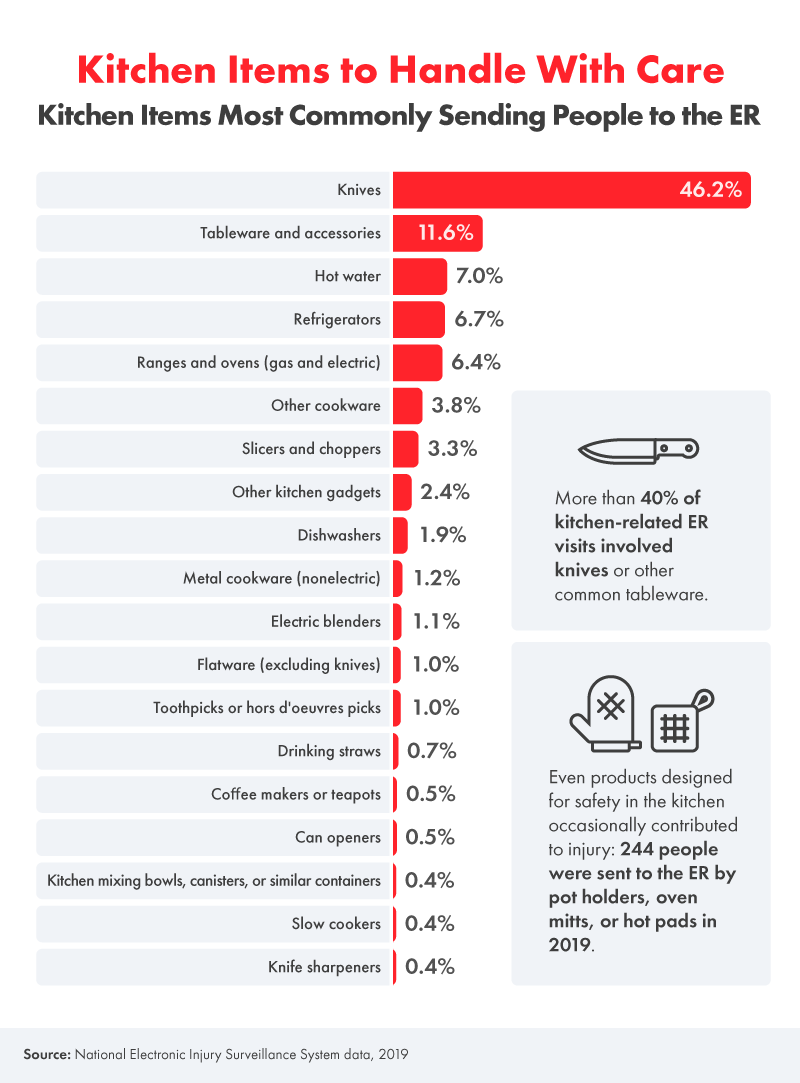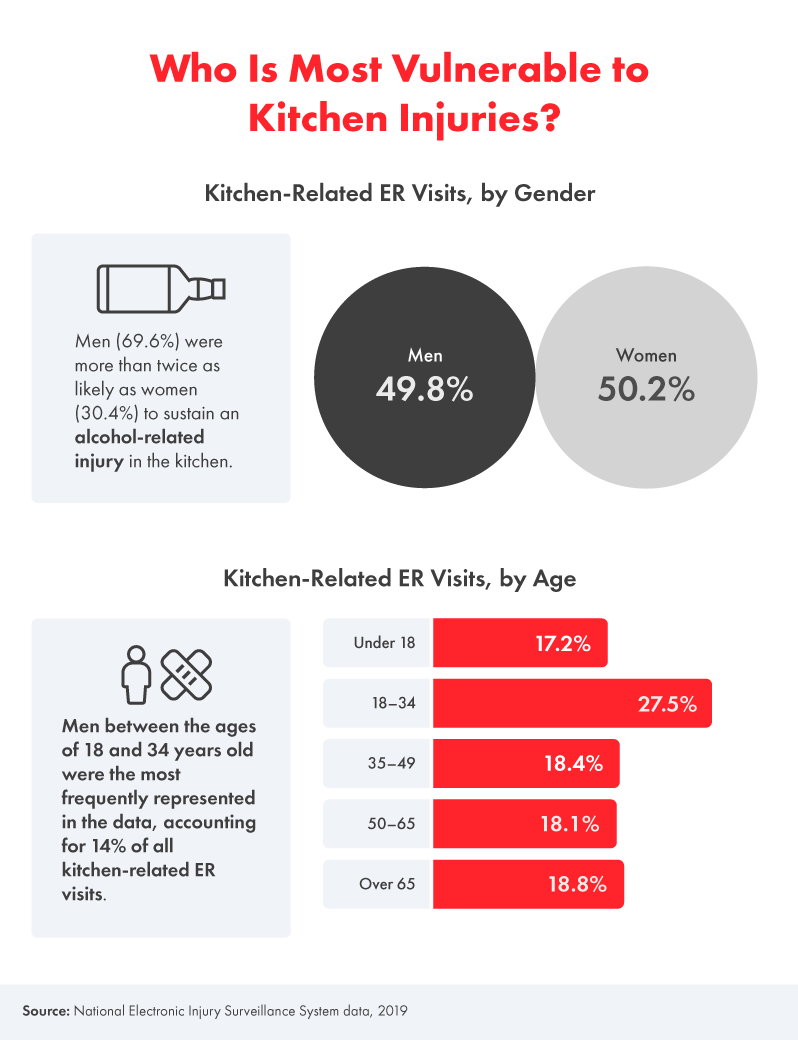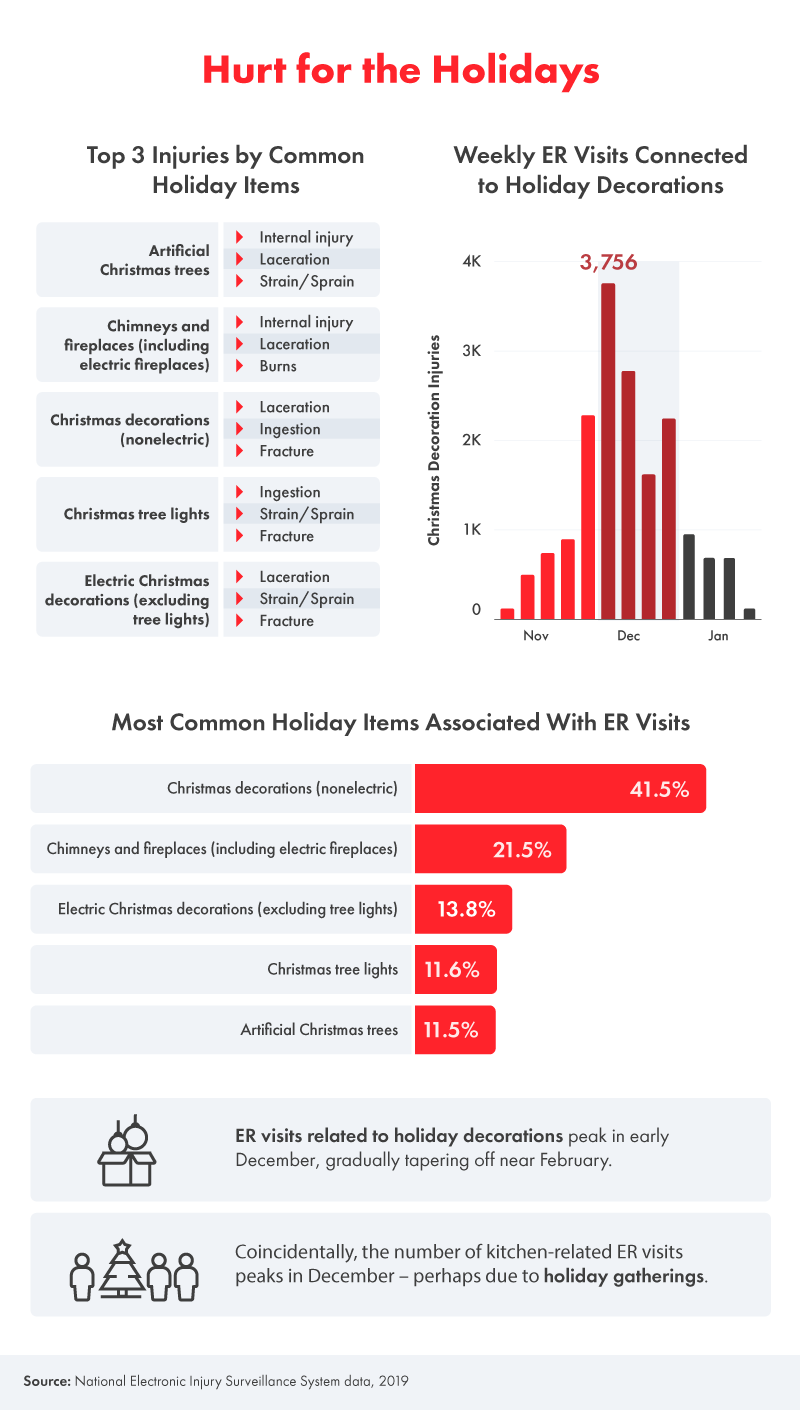Getting Injured at Home
Exploring How Americans are Getting Hurt in Their Own Homes

Home is where we get to kick up our feet at the end of a long day. Home is where we expect to feel safe and comfortable. But as we all know, accidents can happen even in the places where we feel most secure.
Using data from the National Electronic Injury Surveillance System (NEISS) for 2019, we looked at trips to the ER resulting from incidents in the home. We examined the everyday items involved and what body parts were being injured most commonly. Additionally, with the holidays right around the corner, we investigated the prevalence of holiday items causing hospital visits. Read on to see what we found.
Items to Handle With Care in the Kitchen

The kitchen might be among the most important rooms in the home, but it’s also an area that’s ripe with opportunities for injury.
Based on our analysis, the items typically sending people to the ER were pretty predictable. Knives accounted for over 35% of all kitchen injuries, followed by other tableware at 9%. Surprisingly, waste containers, trash baskets, and refuse bins came in as the third most common kitchen item leading to hospital visits. Perhaps some overzealous cooks aren’t watching where they step?
Burns and cuts are both common types of injuries in the kitchen, but there are steps that can be taken to prevent them. While it might seem counterintuitive, sharp knives are safer than dull knives, which can slip out of your hand while in use. As for burns, making sure all handles for pots and pans are turned inward, where they can’t be knocked into, is a good habit to adopt. Keeping pot holders and oven mitts on hand can help too. However, it should be noted that 244 ER visits stemmed from the use of pot holders, oven mitts, or hot pads in 2019, according to the data. Perhaps people were using old or worn items that didn’t end up being very protective.
Cook With Caution

Once we figured out what common kitchen items were causing injuries, we wanted to assess where on their body people were getting injured.
Nearly 38% of kitchen-related incidents that led to ER visits were for injuries to the hand, with another 16.2% to fingers specifically. With lots of chopping, slicing, and dicing happening, it’s not uncommon for a knife to slip. Taking the time to learn proper cutting techniques and safety practices can help reduce the chances of injury.
Hands and fingers weren’t the only appendages in the line of fire. Feet were the third most common body part involved in kitchen injuries, accounting for 5.6% of kitchen-related ER visits. Given that things can fall or spill while cooking, it’s recommended that people wear sturdy, closed-toe shoes while preparing meals.
The Most Accident-Prone Cooks

When looking at who tends to get injured in the kitchen, we saw some interesting trends. The occurrence of ER visits between genders was a fairly equal split, men accounting for 49.8% of kitchen-related ER visits and women accounting for 50.2%. However, men were more than twice as likely as women to sustain an injury involving alcohol in the kitchen.
There was a fairly equal age spread when it came to kitchen injuries, with the exception of people between the ages of 18 and 34. This age group accounted for 27.5% of all kitchen-related ER visits. Reports in recent years have shown that millennials (people born between 1981 and 1996) opt for takeout and dining out more than previous generations. Perhaps this has left them with less culinary experience, making them more accident prone. Others blame technology: With so much information now available on demand, people don’t necessarily learn and practice skills like cooking over a lifetime.
Missteps on Stairs

Another area of the home that can be prime territory for injuries are stairs and staircases. When looking specifically at ER visits stemming from stairs, we found that women and people over the age of 50 were more prone to be hurt while navigating the stairs. Women accounted for 60.7% of stair-related injuries, compared to 39.3% of men. And people over the age of 50 accounted for 48.5% of stair injuries.
We also saw an interesting trend based on the time of year. Stair-related ER visits peaked in December in 2019. There are a few possible explanations for the trend. Perhaps the simple fact that people typically spend more time at home during the cold winter months increases the possibility of sustaining an injury that requires a trip to the hospital. Another possible explanation is that the holiday season, when people typically gather together more, leads to increased foot traffic in the home and could contribute to more injuries.
A Safe Holiday Season

Speaking of the holidays, with the end of the year drawing near, we examined what holiday items have contributed to injuries requiring a trip to the hospital. ER visits are known to spike around this time of year, so it helps to know what the common culprits are.
Nonelectric Christmas decorations accounted for 41.5% of holiday injuries landing people in the ER last year – the most common injuries being lacerations, ingestions, and fractures. Chimneys and fireplaces followed with 21.5% of injuries, which included internal injuries, lacerations, and burns.
Electric Christmas decorations, excluding tree lights, accounted for 13.8% of holiday injuries. The top three injuries sustained by electric Christmas decorations were lacerations, strains/sprains, and fractures.
No one wants to miss out on holiday festivities, so make sure to take the necessary precautions when creating your winter wonderland, both indoors and outdoors. Things like not placing trees near fireplaces or high-traffic areas, keeping ornaments and decorations with small pieces away from young children, and making sure all holiday lights pass safety tests and are in good condition can keep people merry and away from the hospital.
Staying Safe at Home
Home is where many of us feel safest, but accidents are bound to happen. Knowing where injuries can arise is a step toward protecting yourself and your loved ones. Always use kitchen items correctly and carefully, traverse all steps and stairs with care, and don’t let your holiday enthusiasm distract you from the aforementioned safety practices.
Stannah understands the desire to remain independent and safe at home while also being prepared and taking precautions. Our selection of stairlifts offers a variety of features to fit your needs. They’re fully customizable, so you can stay safe wherever you are. For more information, visit us as Stannah-Stairlifts.com.
Methodology
We analyzed 2019 data from the National Electronic Injury Surveillance System, which collects data on consumer product-related injuries occurring in the United States. It is run by the Consumer Product Safety Commission. NEISS data is based on a representative sample of hospitals in the U.S. and U.S. territories.
We specifically looked at data related to kitchen items, stairs, and holiday-related items in our analysis. Percentages were calculated using weighted data provided within the data set.
When examining holiday-related injuries specifically, part of this project looks at the number of holiday-related injuries by week from November to January. All data is from 2019. For the purposes of displaying data in chronological order, some visualizations place January after December on the x-axis. However, it should be noted that this represents December 2019 and January 2019.
Limitations
The NEISS is a statistically valid injury surveillance and follow-back system, but it is worth noting that data is used to generate nationwide estimates of injuries from consumer products. The data does not account for non-product-related injuries.
Fair Use Statement
Staying safe at home, particularly in an unprecedented year like 2020, is of the utmost importance. If someone you know would benefit from the information in this project, you may share for any noncommercial reuse. Please link back here so the entire project and its methodology can be viewed. This also gives credit to the contributors who make this work possible.

 USA
USA